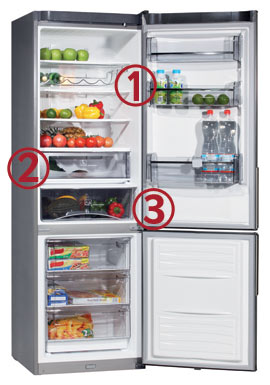Keeping Food Safe
Rules to keep food safe in the fridge and freezer.
Advice on Poultry Handling
Campylobacter is the most common cause of food poisoning in Ireland and occurs naturally in Chicken.
A common cause of Campylobacter poisoning is cross-contamination from raw poultry. SuperValu is working with our supplier and the Working Group recently established by the Department of Agriculture, Forestry & Marine and the FSAI to tackle levels of Campylobacter in poultry.
Here are some easy ways to reduce your risk of illness:
- Use a separate bag for packing raw poultry and raw meats when shopping
- Wash hands with soap before and after preparing or handling raw poultry and meat and before touching anything else
- Do not wash oven ready birds (as this can spread Campylobacter around the kitchen)
- Cook all poultry products thoroughly. The meat is cooked properly when it is no longer pink and the juices from deep inside the meat run clear.
- Do not use the same chopping board for raw meat/poultry and other foods
- Wash all chopping boards, work surfaces and utensils with soap and hot water after preparing raw poultry and meat
Additional information available at:
www.fsai.ie/faqs/campylobacter.html
Storing Food Correctly in the home
- Keep the fridge at 5°C or below.
- Place a mercury-free fridge thermometer on the bottom shelf above the salad drawer, and check the temperature once a week, ideally first thing in the morning.
- The numbers on the fridge thermostat dial do not necessarily show the temperature reading, so check the user handbook and use a thermometer to check the temperature.
- Keep the fridge door closed tightly, as the temperature will rise if the door is left open.
- Don't overpack the fridge, as this can stop cool air from circulating freely and the fridge may not keep the foods properly chilled.
- Don't put hot food in the fridge as this can raise the fridge temperature.
Storing Food Correctly in the Fridge

- Top and Middle Shelves: Ready to Eat Foods such as dairy products, yoghurts, cream, cream cakes, butter and margarine, cooked meats, leftovers (covered), other packaged food, for example coleslaw, ketchup and so on.
- Bottom Shelf: Raw meat, poultry and fish. You should always cover raw meats, poultry and fish and keep them in a sealed container so that they don't touch each other or drip onto other foods.
- Salad Drawer: Salad, vegetables and fruit. Keep ready to eat fruit and vegetables in sealed bags or containers. Always wash raw fruit and vegetables before use.
Handy Hints on Freezing Food
- Freezing is one of the easiest and most convenient methods of preserving foods. Many foods can be frozen in the freezer for 3 months, it's a great way to avoid food waste and save money.
- Only freeze fresh meats and fish or freshly cooked foods (once cooled). Defrost slowly in the fridge.
- Cool food quickly within one to two hours of cooking before freezing.
- Label and date foods so you will know what you have and how long it's in the freezer.
- Freeze food in portion sizes. If you are freezing a large batch of soup, freeze in plastic containers or freezer bags suitable for your family size.
- Make sure you reheat food until it's piping hot (check the centre of the meal is piping hot), and if possible defrost foods overnight in the fridge, you will need to extend cooking times if cooking from frozen.
Tips for Fresh Produce Safety
Safe Handling of Raw Produce
Buying Tips
- Purchase produce that is not bruised or damaged.
- When selecting fresh-cut produce - such as a half a watermelon or bagged salad greens - choose items that are refrigerated or surrounded by ice.
- Bag fresh fruits and vegetables separately from meat, poultry and seafood products.
Storage Tips
- Store perishable fresh fruits and vegetables in a clean refrigerator at a temperature of 4°C or below.
- Refrigerate all produce that is purchased pre-cut or peeled.
Preparation Tips
- Begin with clean hands. Wash your hands for 20 seconds with warm water and soap before and after preparing fresh produce.
- Cut away any damaged or bruised areas on fresh fruits and vegetables. Produce that looks rotten should be discarded.
- All produce should be thoroughly washed before eating. Wash fruits and vegetables under running water just before eating, cutting or cooking.
- Many precut, bagged produce items like lettuce are pre-washed. If the package indicates that the contents have been pre-washed, you can use the produce without further washing.
- Even if you plan to peel the produce before eating, it is still important to wash it first.
- Washing fruits and vegetables with soap or detergent or using commercial produce washes is not recommended.
- Scrub firm produce, such as melons and cucumbers, with a clean produce brush.
- Drying produce with a clean cloth towel or paper towel may further reduce bacteria that may be present.